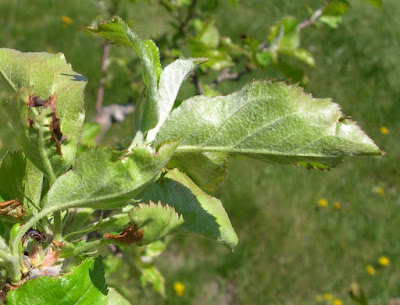CAUTION: The
observations, conditions, and recommendations reported for Winchester, VA are
provided as a guide to fire blight risk assessment only for the immediate area
of the Virginia Tech AREC located six miles southwest of Winchester. Use of the
information reported here for making orchard management decisions outside of
that area is not our intent. Fruit producers outside of that area are
encouraged to consult their state extension specialists for information similar
to that provided here.
 |
| Maryblyt outlook April 25, 2016 |
FIRE BLIGHT:
Above is a cropped graphic from the Maryblyt 7 program. Susceptible flowers are
still open on most cultivars. Here is the prediction for trees with first bloom
open Monday, April 11, 2016. The temperature and rainfall data are current
through Monday morning, April 25. Predicted weather conditions are shown for
April 25-29. The components of fire blight risk are indicated in the columns
labeled B (blossoms open), H (degree hours for epiphytic bacterial
populations), W (wetting by rain or dew), and T (average daily temperature 60 F
or above). For infection to be predicted, wetting must occur after the EIP
(epiphytic infection potential) reaches 100 or higher, which has been true
since Apr 18. Based on predicted temperatures, the risk column shows infection
conditions for Apr 21, 22 and 23 and only wetting is lacking for Apr 25-27. In situations where all other requirements for infection have been
met except wetting, wetting from a maintenance spray application can provide
the wetting trigger for infection to occur. In high-risk situations, a
protective streptomycin application is recommended ahead of predicted
infection. A streptomycin spray remains effective about 3 days in warmer
conditions when it is needed most and can provide about one day after-infection
suppression.
The BBS column
is tracking predicted symptom development for the first infection Apr 21. The
CBS column indicates progression toward the appearance of canker margin
symptoms due to extension of overwintering cankers from last year, which are
predicted to occur when that value reaches 100 Apr 27. Canker advancement
cannot be prevented by chemical treatment at this time and the presence of
symptoms will signal build-up of inoculum which could become a factor in the
event of a trauma blight situation due to hail injury, etc.
The weather
conditions used in the predictive part of this graphic come from the Weather Channel for Winchester, supplemented by site-specific data from SkyBit Inc. Be aware
that risk can change quickly with unpredicted warmer temperatures and wetting.
The fire blight outlook will be updated Wednesday, Apr 27.
OTHER DISEASES: We recorded a 15-hr scab, cedar-apple rust and quince rust infection period Apr 22-23. The infection period was as long as 23 hr in Tyro, VA. Where fungicides were not applied recently enough to cover through this infection event, we suggest ones with after-infection activity for scab and rusts, applied as soon as possible.
 |
| Cedar-apple rust galls with expanded spore horns April 22, 2016. |
Meanwhile, powdery mildew has been by far our most active apple disease so far this year. Mildew is our only "dry weather" disease and we have had 24 infection days since spores were first available March 16. Secondary infection, shown below, has been evident for at least two weeks.
 |
| Secondary powdery mildew infection, Ginger Gold apple. |
Peach leaf curl infection occurred at our AREC as early as March 13. Complete control can be achieved with a single application of an effective fungicide in the dormant season any time from leaf drop in the fall until just before infection occurs with wetting after first bud swell in the spring.
 |
| Peach leaf curl, Turk Mt. Overlook, Skyline Drive, Virginia |
Finally, after the early season we have had this year, we are happy to see peach and apple trees making little fruits at our AREC!
 |
| Shuck-split stage on Redhaven peach, April 22, 2016, |




